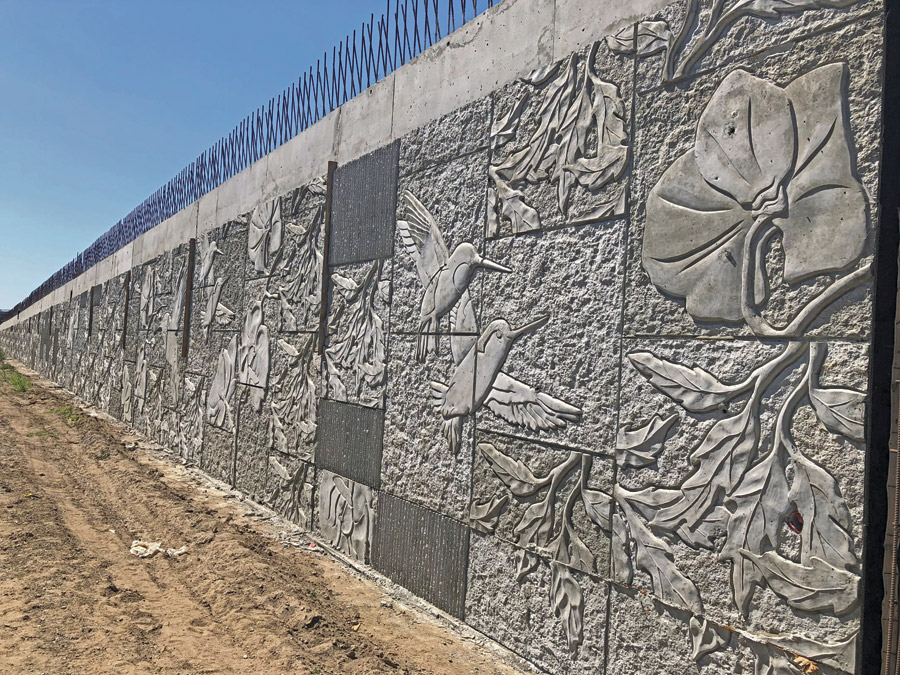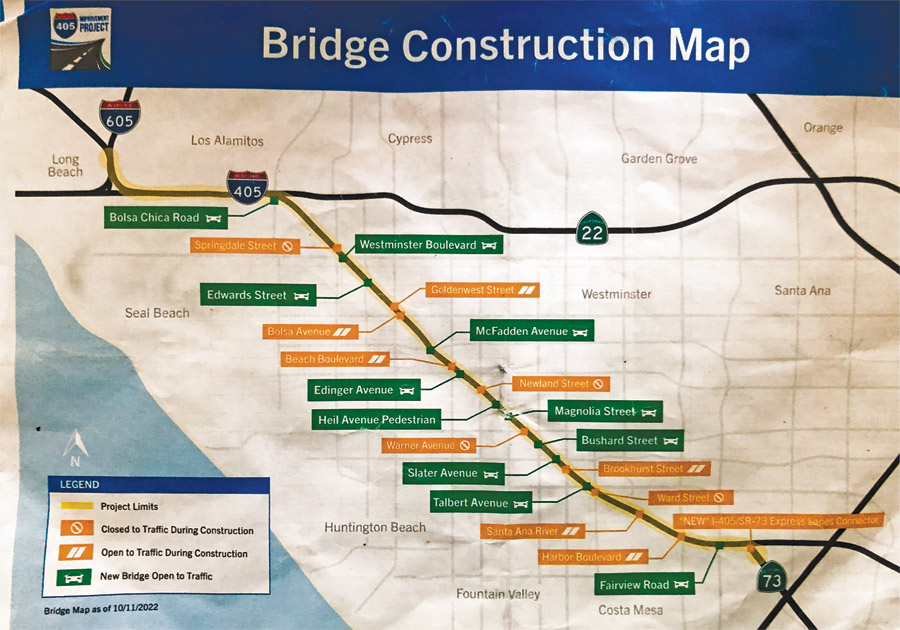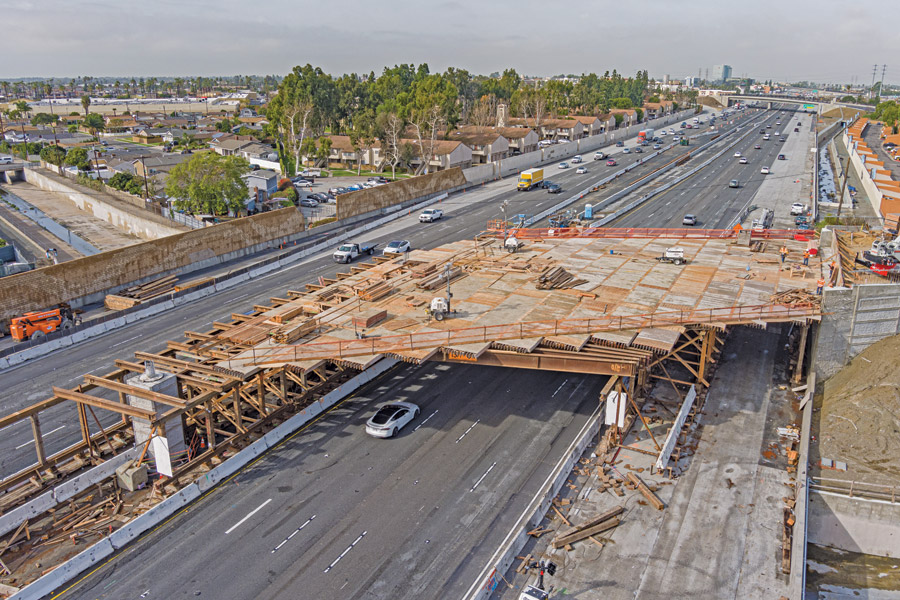Challenges abounded on a project to widen and improve a 16-mile section of one of Southern California’s busiest freeways. Despite skeletons, skews and a lawsuit, a design-build team is successfully wrapping up the $2-billion I-405 Improvement Project this year in Orange County.
The Orange County Transportation Authority (OCTA), in partnership with the California Dept. of Transportation (Caltrans), oversees the project. OCTA worked with nine cities and communities along the corridor, which stretches from Costa Mesa to the Los Angeles County line in the city of Long Beach.
Funded in large part by a county half-cent sales tax for transportation enhancements, the sprawling project is intended to reduce commute times by adding a general lane in each direction, and two lanes in each direction between State Route 73 and I-605. OCTA estimates that commute times will be reduced by half for nearly 400,000 daily drivers.
OC Go, also known as Measure M, is a 30-year half-cent sales tax for transportation improvements in Orange County from 2011 through 2041.

Bridges had to be widened to accommodate the wider freeway.
Photo courtesy of OCTA
“We couldn’t afford” to start the project under the initial half-cent measure, says Darrell Johnson, OCTA chief executive officer. Along with revenue from OC Go, OCTA secured a $629-million federal loan through the Transportation Finance and Innovation Act (TIFIA) in 2017. In 2021, OCTA took advantage of historically low interest rates, becoming the first agency to ever reset a partially drawn TIFIA loan. Revenue collected from the drivers who use the 405 Express Lanes will be used to repay the TIFIA loan.
Toll revenue collected beyond what it costs to operate the express lanes and repay the TIFIA loan will fund future transportation improvements for everyone who travels throughout the 405 corridor, whether or not they use the express lanes.
The environmental review process in 2012 also had to be redone, Johnson recalls. “We didn’t do a great job communicating to the public. We needed to reset.”
Hundreds of meetings ensued. “OCTA committed to delivering a robust outreach effort from the very beginning of the public participation process,” says Adolfo Ozaeta, assistant city manager with the city of Westminster. “The OCTA outreach team established technical working group meetings, elected official stakeholder meetings, formal community meetings and more relaxed community pop-ups at public parks where residents could share their thoughts and concerns with project team members. There were also meetings with members of business districts, school districts, major employers and police and fire departments along the project corridor.”
OCTA also launched an incentive program that encouraged property owners to agree to rights-of-way acquisitions in 60 days for payments. Eighty percent agreed, says Jeff Mills, OCTA’s project manager. OCTA had to make almost 300 ROW acquisitions for the project.
Johnson says that the agency is now deploying the incentive program on other projects.
The city of Long Beach filed a lawsuit in 2015 alleging that the project could cause “serious traffic impacts in Long Beach and that Caltrans and OCTA had failed to properly analyze or mitigate these impacts in the Environmental Impact Report (EIR) for the project,” according to a news release. Two years later, the suit was settled with OCTA and Caltrans agreeing to fund $13 million in traffic mitigation projects for the city.

Sound walls and bridge facades have designs that reflect the different communities along the corridor.
Photo courtesy of OCTA
Angles of Approach
OCTA awarded a $1.2-billion contract to OC 405 Partners, which beat out two other bidders. It is a joint venture between OHLA USA Inc. and Astaldi Construction Corp., formed in 2016. It was not only the county’s largest design-build project, but one of the first under California’s then newly enacted legislation allowing design-build for highway projects.
Johnson recalls that the project benefited from two other laws that passed: one that allowed OCTA to keep excess toll revenue within its corridors and another giving the California Transportation Commission the legislative responsibility to approve the tolling of transportation facilities. The design-build process shaved two years off construction time, says Johnson.
“We’re building not one bridge at a time, but 10 at a time.”
—Alex Medyn, Executive VP, Western Region, OHLA
The team includes Myers & Sons Construction LP; All American Asphalt; MCM Construction Inc.; a Pacific Infrastructure 405 Designers joint venture; Arup North America Ltd.; H.W. Lochner Inc.; and Moffatt & Nichol. Key elements include adding a general-purpose lane in each direction of I-405 from Euclid Street to the I-405/I-605 interchange, addition of a tolled express lane in each direction from SR-73 to SR-22, extended or new auxiliary lanes and upgraded drainage.
The new tolled express lanes will combine with the existing high-occupancy vehicle lane to create two express lanes in each direction in the I-405 median from SR 73 to I-605.
The alignment does not travel directly north-south through Orange County but instead curves from northwest to southeast. Thus, the 18 replacement bridges cross the alignment on a skew, notes Mills. “Some go across the freeway at a 90-degree angle,” he says. That meant greater heights of bridges and deeper foundations, yet grades could be no greater than 6%.

The geometry of I-405 in Orange County is at a skew, affecting the construction of bridges crossing it.
Map courtesy of OCTA
“Construction-wise, there’s just about every discipline I’ve seen in 22 years of highway construction experience,” says Alex Medyn, Western region executive vice president with OHLA. “We are building bridges not one at a time, but 10 at a time. Falsework designs are complicated. There are limited clearances. There are right-of-way constraints.”
Utility crews were at work from the first day, he recalls. More than 100 utilities had to be relocated, with 400 identified and protected. “We have had crews working 24-hour shifts in some capacity since the beginning,” adds Medyn.
The bridges are a mix of cast-in-place and precast girder types, says Mills, with the longest reaching 1,200 ft. About a third were built in two stages, while others were built in one stage through collaboration with the cities they were in. Moreover, aesthetic designs along the sides of many bridges and sound walls vary according to the community in which they are located.

I-405 will have new express toll lanes as well as an additional general lane.
Photo courtesy of OCTA
Finish Line
Eleven of the 18 bridges are complete, and the remaining seven will be completed this summer, according to an OCTA spokesperson. Other milestones this year include completing the final ramp connecting I-405 to the local streets, all sound walls and concrete paving.
Discovery of Native American artifacts and bones in 2020, and leaking oil lines, pushed the project cost from $1.9 billion to $2.16 billion, but the schedule delay has not been significant. Still pending is a lawsuit filed by Myers & Sons against the design-build team in 2020, alleging they undermined its role as primary bridge contractor. The trial is set for this fall in the state Superior Court.
“OCTA committed to delivering a robust outreach process from the very beginning.”
—Adolfo Ozaeta, Assistant City Manager, Westminster
Under the 16% DBE goal, High Light Electric Inc. gained valuable design-build experience, working on traffic signals, lighting, communications and tolling systems, says its CEO Erwin Mendoza. “We were able to open another support staff office to help with the flow of the work. This employed a lot of people.” Future DBE programs should ensure prompt payment and commit to a quicker resolution process for small firms, he adds.
The improvements will “eliminate drop lanes and bottlenecks that have existed for decades, resulting in less traffic delays on city streets as well as safety enhancements,” says Ozaeta. “The new bridges are constructed to the latest seismic standards and contain new and upgraded utilities such as essential water lines and fiber optic communication. The freeway project also resulted in the dedication of land to the city of Westminster that increased the city’s park space; this is virtually unheard of on a project of this type.”




